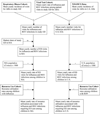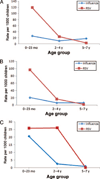Relative impact of influenza and respiratory syncytial virus in young children
- PMID: 19933730
- PMCID: PMC3374864
- DOI: 10.1542/peds.2008-3074
Relative impact of influenza and respiratory syncytial virus in young children
Abstract
Objective: We measured the relative impact of influenza and respiratory syncytial virus (RSV) infections in young children in terms of emergency department (ED) visits, clinical care requirements, and overall resource use.
Methods: Patients who were aged <or=7 years and treated in the ED of a tertiary care pediatric hospital for an acute respiratory infection were enrolled during 2 winter seasons between 2003 and 2005. We quantified health care resource use for children with influenza or RSV infections, and extrapolated results to estimate the national resource use associated with influenza and RSV infections.
Results: Nationally, an estimated 10.2 ED visits per 1000 children were attributable to influenza and 21.5 visits per 1000 to RSV. Children who were aged 0 to 23 months and infected with RSV had the highest rate of ED visits with 64.4 visits per 1000 children. Significantly more children required hospitalization as a result of an RSV infection compared with influenza, with national hospitalization rates of 8.5 and 1.4 per 1000 children, respectively. The total number of workdays missed yearly by caregivers of children who required ED care was 246965 days for influenza infections and 716404 days for RSV infections.
Conclusion: For young children, RSV is associated with higher rates of ED visits, hospitalization, and caregiver resource use than is influenza. Our results provide data on the large number of children who receive outpatient care for influenza and RSV illnesses and serve to inform analyses of prevention programs and treatments for both influenza and RSV disease.
Figures



References
-
- Simoes EA. Respiratory syncytial virus infection. Lancet. 1999;354(9181):847–852. - PubMed
-
- Shay DK, Holman RC, Newman RD, Liu LL, Stout JW, Anderson LJ. Bronchiolitis-associated hospitalizations among US children, 1980–1996. JAMA. 1999;282(15):1440–1446. - PubMed
-
- Thompson WW, Shay DK, Weintraub E, et al. Mortality associated with influenza and respiratory syncytial virus in the United States. JAMA. 2003;289(2):179–186. - PubMed
-
- Neuzil KM, Mellen BG, Wright PF, Mitchel EF, Jr, Griffin MR. The effect of influenza on hospitalizations, outpatient visits, and courses of antibiotics in children. N Engl J Med. 2000;342(4):225–231. - PubMed
Publication types
MeSH terms
Substances
Grants and funding
LinkOut - more resources
Full Text Sources
Other Literature Sources
Medical

